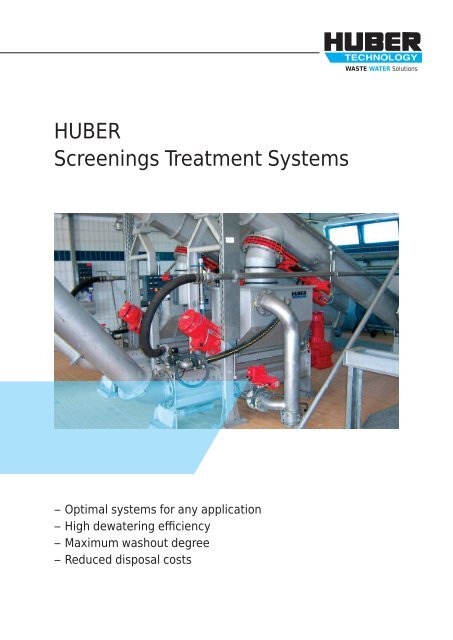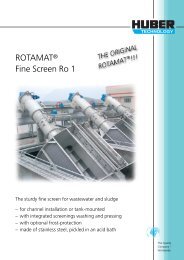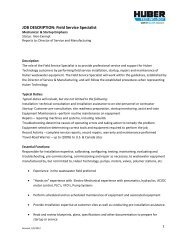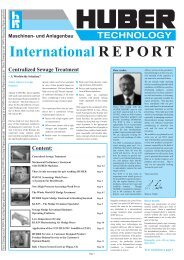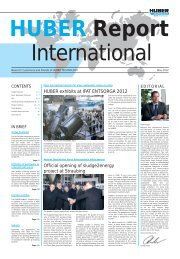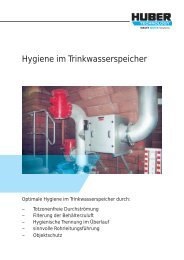Overview Brochure Screenings Treatment - huber se
Overview Brochure Screenings Treatment - huber se
Overview Brochure Screenings Treatment - huber se
You also want an ePaper? Increase the reach of your titles
YUMPU automatically turns print PDFs into web optimized ePapers that Google loves.
WASTE WATER Solutions<br />
HUBER<br />
<strong>Screenings</strong> <strong>Treatment</strong> Systems<br />
– Optimal systems for any application<br />
– High dewatering efficiency<br />
– Maximum washout degree<br />
– Reduced disposal costs
➤ Why screenings treatment?<br />
<strong>Screenings</strong> are normally produced by screens in waste<br />
treatment plants (wastewater treatment plants, pumping<br />
stations, etc.) and predominantly consist of material<br />
similar to domestic waste, faeces, paper and mineral<br />
materials. The screenings volume produced is dependent<br />
upon the <strong>se</strong>paration size of the screen, the <strong>se</strong>wer system<br />
and the pre ceding pumping stations.<br />
The water content of municipal screenings varies between<br />
10 % and 25 %, depending upon the type of screen u<strong>se</strong>d<br />
whilst the organics contained within the screenings<br />
amount on average to approx. 90 % of the dry residue [DR].<br />
Due to the very high water content, the very hetero -<br />
genous composition and unanesthetic appearance<br />
screenings must be pretreated prior to disposal. The best<br />
pretreatment systems are screenings wash pres<strong>se</strong>s that<br />
wash out faeces and suspended organic material through<br />
addition of wash water and mecha nical energy. As a<br />
result, a BOD 5 load increa<strong>se</strong> of up to 6 % at the inlet to<br />
the biological treatment stage can be expected. After<br />
washing, the screenings are compacted to achieve a<br />
significant reduction of the water content within the<br />
washed screenings and due to the washout of faeces<br />
screenings dewatering is often significantly improved.<br />
Dependent upon the <strong>se</strong>lected washing process and press<br />
type a weight and volume reduction of up to 80 % can be<br />
achieved. The weight reduction reduces the screenings<br />
disposal volume and has thus a direct impact on screen -<br />
ings disposal costs.<br />
Unwashed screenings<br />
Washed screenings<br />
➤ Integrated <strong>Screenings</strong> Washing System IRGA<br />
Design and function<br />
All HUBER ROTAMAT® screens can be equipped with<br />
the IRGA system that washes the screenings within<br />
the screen basket to remove virtually all faeces. The<br />
screenings press integrated in the ROTAMAT® screen's<br />
rising pipe dewaters the screenings to up to 40 % DR.<br />
Wastewater from the channel or process water can be<br />
u<strong>se</strong>d as wash water. The press liquor returns to the<br />
channel.<br />
The u<strong>se</strong>r's benefits<br />
➤ Increa<strong>se</strong>d dewatering performance of up to 40 % DS<br />
➤ Volume, weight and disposal cost reduction by<br />
up to 70 %<br />
➤ Easy retrofit<br />
IRGA flow diagramm
➤ HUBER <strong>Screenings</strong> Wash Press WAP<br />
Design and function<br />
The screenings to be treated are discharged directly from<br />
a screen or conveyor (e.g. screw conveyor) into the feed<br />
trough of the Wash Press. A robust convey ing and com -<br />
pacting screw transports the screenings into the wash<br />
zone where they are expo<strong>se</strong>d to directed and powerful<br />
turbulence created by auto matic introduction of wash<br />
water (u<strong>se</strong>d water). The high turbulence guarantees<br />
perfect <strong>se</strong>paration of organic particles and thus effective<br />
screenings washing. The washing intensity and cycles are<br />
individually adjustable.<br />
The washed screenings are further conveyed in the<br />
rising pipe to the press zone where they are pres<strong>se</strong>d and<br />
dewatered by the compacting screw to a DS content of<br />
35 – 45%. The filtrate from screenings compaction is rich<br />
in carbon and returned to the wastewater stream. Auto -<br />
matic flushing of the wash water collecting tank under<br />
the machine is possible. The washed and compacted<br />
screenings are finally pushed through the conical dis -<br />
charge pipe into a container.<br />
The u<strong>se</strong>r's benefits<br />
➤ Dewatering performance of up to 45 % DR<br />
➤ Volume, weight and disposal cost reduction<br />
by up to 75 %<br />
➤ <strong>Screenings</strong> throughput capacity of up to 12 m 3 /h<br />
Reliable and efficient – HUBER <strong>Screenings</strong> Wash Press WAP<br />
➤ Completely made of stainless steel (including the<br />
compacting screw)<br />
➤ Made of stainless steel for corrosion protection<br />
➤ Return of carbon-rich filtrate to the wastewater<br />
➤ In<strong>se</strong>nsitive to coar<strong>se</strong> material<br />
➤ Screened wastewater or process water can be u<strong>se</strong>d<br />
as wash water<br />
➤ Flexible feed trough lengths<br />
➤ High economic efficiency due to reduced transport<br />
and disposal costs<br />
➤ Low investment costs<br />
➤ HUBER Wash Press WAP-L for launder channel operation<br />
The screenings to be treated are discharged from a<br />
screen into a launder channel and flushed into the Wash<br />
Press. Service water is u<strong>se</strong>d as flush water. The transport<br />
water (free water) is returned to the system through a<br />
perforated plate. The screenings washing cycle starts<br />
when a defined amount of screenings has been intro -<br />
duced. The screenings are washed, compacted and<br />
conveyed into a skip via a conical discharge pipe. The<br />
carbon-rich wash water is discharged to the channel.<br />
This cost-effective screenings transport and treatment<br />
system provides up to 40 m launder channel length and<br />
offers operating reliability and flexibility to provide<br />
customi<strong>se</strong>d solutions.<br />
The u<strong>se</strong>r’s benefits<br />
➤ <strong>Screenings</strong> wash press for increa<strong>se</strong>d dewatering<br />
with launder channel feeding system<br />
➤ Dewatering performance of up to 45 % DR<br />
➤ Throughput capacity up to 12 m³/h<br />
➤ Individually adaptable discharge situations due to<br />
flexible launder channel arrangement<br />
➤ Up to 40 m launder channel length<br />
Redundant operation and optimal screenings dewatering<br />
with launder channel feeding system<br />
➤ Screened wastewater or process water can be u<strong>se</strong>d as<br />
wash and flush water
WASTE WATER Solutions<br />
➤ HUBER <strong>Screenings</strong> Wash Press WAP/SL<br />
Design and function<br />
The WAP/SL operates in a batch mode. <strong>Screenings</strong> either<br />
drop into the launder tank directly from a screen or<br />
conveyor, or they are flushed into the tank through a<br />
launder channel. After a batch of screen ings has been fed,<br />
the tank is filled up with wash water and agitated for an<br />
adjustable period by means of an impeller. The fecal<br />
matter is loo<strong>se</strong>ned and removed from the screenings by<br />
high turbu lence and shear.<br />
After the washing cycle has been finished, an automatic<br />
valve opens and the wash water drains through perfora -<br />
tions in the trough. It returns, together with the fecal<br />
matter, to the wastewater flow. A screw in the trough<br />
conveys the screenings towards the mouth of a tube<br />
whereby they are, as an additional option, rin<strong>se</strong>d with<br />
spray water. The screw pushes the screenings through<br />
the pressure zone where they are compres<strong>se</strong>d, dewatered<br />
and compacted before they are finally discharged through<br />
the discharge pipe into a dumpster or bagger.<br />
Outdoor installation of a HUBER <strong>Screenings</strong> Wash Press<br />
WAP/SL<br />
The u<strong>se</strong>r's benefits<br />
➤ Very clean screenings due to high-intensity<br />
washing in launder tank<br />
➤ Dewatering performance up to 50 % DR<br />
➤ Volume, weight and disposal cost reduction by<br />
up to 85 %<br />
➤ <strong>Screenings</strong> throughput capacity of up to 6 m 3 /h<br />
➤ Return of carbon-rich filtrate to the wastewater<br />
➤ Screened wastewater or process water can be<br />
u<strong>se</strong>d as wash water.<br />
➤ Completely enca<strong>se</strong>d unit, no odour nuisance<br />
➤ HUBER <strong>Screenings</strong> Wash Press WAP/HP<br />
Design and function<br />
The screenings to be treated are discharged directly from<br />
a screen or conveyor (e.g. screw conveyor) into the feed<br />
trough of the Wash Press. A robust conveying and<br />
compacting screw transports the screenings into the<br />
wash zone where they are expo<strong>se</strong>d to directed and<br />
powerful turbulence created by automatic introduction of<br />
wash water (<strong>se</strong>rvice water). The turbulence achieves<br />
perfect <strong>se</strong>paration of organic particles and thus effective<br />
screenings washing. The washing intensity and cycles are<br />
individually adjustable. The washed screenings are<br />
further conveyed in the rising pipe to the press zone<br />
where they are intensively pre-pres<strong>se</strong>d by the compacting<br />
screw. In the following <strong>se</strong>cond press zone the screenings<br />
are compacted and dewatered under high pressure to a<br />
DS content of up to 60 %. Especially wear-resistant and<br />
solid materials in the conical high-pressure unit ensure<br />
reliable long-term operation of the plant.<br />
The press water from screenings compaction is collected<br />
under the high-pressure unit and dis charged along with<br />
the wash water which is rich in carbon. Automatic clean -<br />
ing with water of the wear collecting tank under the<br />
machine and the complete high-pressure unit is possible.<br />
The washed and com pacted screenings are finally trans -<br />
ported through the conical discharge pipe into a container.<br />
Increa<strong>se</strong>d DR with high pressure – the HUBER <strong>Screenings</strong><br />
Wash Press WAP/HP<br />
The u<strong>se</strong>r's benefits<br />
➤ Dewatering performance up to 60 % DR<br />
➤ Volume, weight and disposal cost reduction by<br />
up to 80 %<br />
➤ Hydraulically controlled high-pressure zone<br />
➤ Made of stainless steel for corrosion protection<br />
➤ In<strong>se</strong>nsitive to coar<strong>se</strong> material<br />
➤ Compacting screw with reinforced flights for<br />
wear protection
➤ HUBER <strong>Screenings</strong> Wash Press WAP/SL/HP<br />
Design and function<br />
The HUBER <strong>Screenings</strong> Wash Press WAP/SL/HP operates<br />
in a batch mode. <strong>Screenings</strong> either drop into the launder<br />
tank directly from a screen or con veyor, or they are<br />
flushed into the tank through a launder channel. After a<br />
batch of screenings has been fed, the tank is filled up<br />
with wash water and agitated for an adjustable period by<br />
means of an impeller. The feacal matter is loo<strong>se</strong>ned and<br />
removed from the screenings by high turbulence and<br />
shear. The washing intensity is <strong>se</strong>lectable and can be<br />
adjusted to suit the specific screenings quality. After the<br />
washing cycle has been finished, an automatic valve<br />
opens and the wash water drains through perforations in<br />
the trough. It returns, together with the faecal matter, to<br />
the wastewater flow.<br />
The washed screenings are further conveyed into the<br />
press zone where they are dewatered by means of a<br />
sturdy compacting screw. In the following auto matically<br />
controlled <strong>se</strong>cond press zone the screen ings are constant -<br />
ly compacted and dewatered under high pressure to a DS<br />
content of up to 60 %. Especially wear-resistant and solid<br />
materials in the conical high-pressure unit ensure reliable<br />
long-term operation of the plant. The press water from<br />
the screenings compaction is collected under the highpressure<br />
unit and discharged along with the wash water<br />
which is rich in carbon. Automatic cleaning with water of<br />
the press and wash water collecting tank under the<br />
machine and the complete high-pressure unit is possible.<br />
The washed and com pacted screenings are finally trans -<br />
ported through the conical discharge pipe into a container.<br />
The HUBER <strong>Screenings</strong> Wash Press WAP/SL/HP for optimal<br />
screenings treatment<br />
The u<strong>se</strong>r's benefits<br />
➤ Very clean screenings due to high-intensity<br />
washing in launder tank<br />
➤ Dewatering performance of up to 60 % DR<br />
➤ Volume, weight and disposal cost reduction of<br />
up to 85 %<br />
➤ Hydraulically controlled high-pressure zone<br />
➤ Return of carbon-rich filtrate to the wastewater<br />
➤ Screened wastewater or process water can be<br />
u<strong>se</strong>d as wash water<br />
➤ In<strong>se</strong>nsitive to coar<strong>se</strong> material<br />
➤ Made of stainless steel for corrosion protection<br />
➤ Compacting screw with reinforced flights for<br />
wear protection<br />
➤ HUBER Wash Press WAP-liquid<br />
Design and function<br />
The HUBER Wash Press WAP-liquid has especially been<br />
designed for dewatering and compacting preferably fine<br />
liquid screenings. The screenings to be treated are for<br />
example pumped into the feed trough of the Wash Press<br />
or fed directly from a screen or conveying unit, e.g. screw<br />
conveyor or launder channel.<br />
The free water flows through the very fine perforated<br />
plate and the collection trough below the machine into<br />
the channel. A sturdy conveying and compacting screw<br />
transports the screenings into the clo<strong>se</strong>d pipe of the<br />
dewatering & compaction zone from where the material is<br />
further conveyed to the press zone and dewatered to a<br />
DR content of 30 – 40% by the press screw. The carbonrich<br />
press liquor is discharged into the channel. The<br />
collection trough below the machine can automatically be<br />
cleaned with water. The compacted screenings are finally<br />
transported through the conical discharge pipe into a<br />
skip.<br />
HUBER Wash Press WAP-liquid<br />
The u<strong>se</strong>r’s benefits<br />
➤ Up to 40% dewatering degree<br />
➤ Very high hydraulic throughput capacity<br />
➤ Dewatering of liquid fine screenings, e.g.<br />
fed by pump or via launder channel<br />
➤ 0.75 / 1 / 1.5 mm perforated plate<br />
➤ Removable perforated plate in<strong>se</strong>rt for<br />
optimal maintenance
WASTE WATER Solutions<br />
➤ Installation Examples<br />
HUBER Wash Press WAP-SL treating the screenings from a<br />
HUBER Rotary Drum Fine Screen Ro 2, high-efficiency<br />
screenings washing for optimal carbon return<br />
Redundantly operated HUBER Wash Press WAP-SL units<br />
with launder channel feeding system. Totally enclo<strong>se</strong>d,<br />
odour-free stainless steel design.<br />
6 HUBER Belt Screen EscaMax® units with HUBER Wash<br />
Press WAP-SL: individually adaptable discharge due to<br />
flexible launder channel arrangement<br />
HUBER Wash Press WAP fed by a ROTAMAT® Screw Con -<br />
veyor Ro 8t for a dewatering performance up to 45 % DR<br />
3 STEP SCREEN® Flexible SSF units and HUBER Wash<br />
Press WAP-HP with automatically controlled hydraulic<br />
counter-pressure unit for up to 60% DR<br />
3 HUBER Wash Press WAP-SL units, size 12, maximum<br />
throughput 12 m³/h, with launder channel feeding system.<br />
Maximum available launder channel length: 40 m.<br />
HUBER SE<br />
Industriepark Erasbach A1 · D-92334 Berching<br />
Phone: + 49 - 84 62 - 201 - 0 · Fax: + 49 - 84 62 - 201 - 810<br />
info@<strong>huber</strong>.de · Internet: www.<strong>huber</strong>.de<br />
Subject to technical modification<br />
0,2 / 5 – 4.2014 – 5.2005<br />
HUBER <strong>Screenings</strong> <strong>Treatment</strong> Systems


